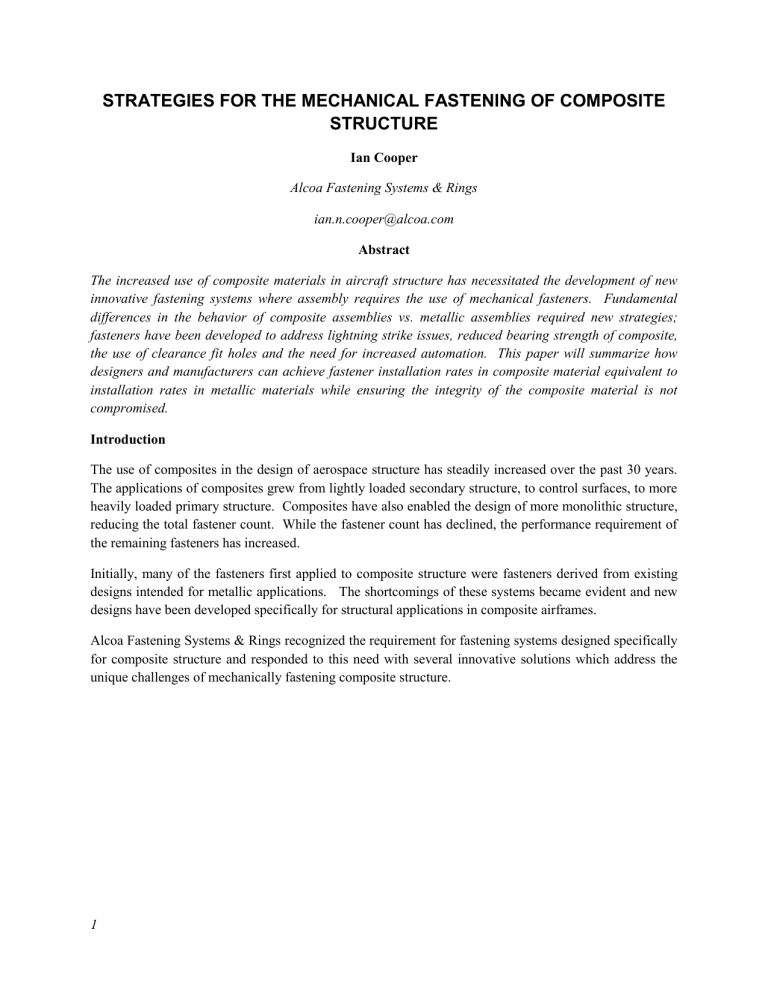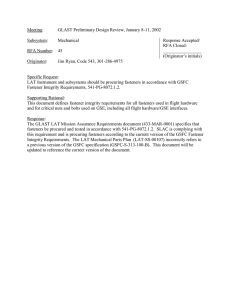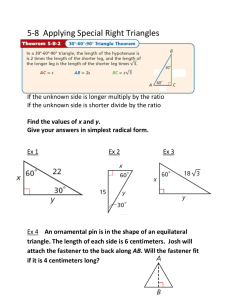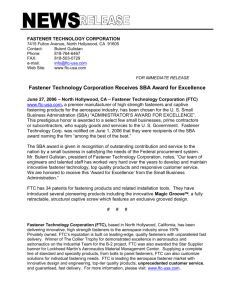strategies for the mechanical fastening of composite structure

STRATEGIES FOR THE MECHANICAL FASTENING OF COMPOSITE
STRUCTURE
Ian Cooper
Alcoa Fastening Systems & Rings ian.n.cooper@alcoa.com
Abstract
The increased use of composite materials in aircraft structure has necessitated the development of new innovative fastening systems where assembly requires the use of mechanical fasteners. Fundamental differences in the behavior of composite assemblies vs. metallic assemblies required new strategies; fasteners have been developed to address lightning strike issues, reduced bearing strength of composite, the use of clearance fit holes and the need for increased automation. This paper will summarize how designers and manufacturers can achieve fastener installation rates in composite material equivalent to installation rates in metallic materials while ensuring the integrity of the composite material is not compromised.
Introduction
The use of composites in the design of aerospace structure has steadily increased over the past 30 years.
The applications of composites grew from lightly loaded secondary structure, to control surfaces, to more heavily loaded primary structure. Composites have also enabled the design of more monolithic structure, reducing the total fastener count. While the fastener count has declined, the performance requirement of the remaining fasteners has increased.
Initially, many of the fasteners first applied to composite structure were fasteners derived from existing designs intended for metallic applications. The shortcomings of these systems became evident and new designs have been developed specifically for structural applications in composite airframes.
Alcoa Fastening Systems & Rings recognized the requirement for fastening systems designed specifically for composite structure and responded to this need with several innovative solutions which address the unique challenges of mechanically fastening composite structure.
1
Considerations for the Mechanical Fastening of Composite Joints
1.
Material Compatibility vs. Carbon Fiber
Figure 1: Material Compatibility vs. Carbon Fiber
In order to avoid the creation of a galvanic couple, the use of carbon fiber has driven fastener selection to more compatible, and lightweight, metals such as titanium. The move to titanium has also been driven by a desire to eliminate the use of cadmium throughout the aircraft.
2.
Load Transfer Efficiency
Joint Material Considerations: Carbon Fiber vs.
Aluminum
Fastener Considerations
Lower Bearing Strength
Lower Ductility
Potential Delamination
Brooming
“Volcano” Formation
Dimensional Control
Large Variety of Material Types and
Properties
Larger Fastener Heads / Tails
130° Countersunk Heads
Avoidance of Relative Motion between
Fastener and Structure
Tighter Shank Tolerances or Sleeved
Fasteners
Low, Controlled Preload
Blind Side Upset Formation
Greater Grip Tolerance
Variety of Fasteners Required
Table 1: Load Transfer Considerations
2
3.
Electromagnetic Energy Exposure
Figure 2: Lightning Strike Test; left, spark free fastener, right, sparked fastener
Aircraft composite structures are more susceptible to lightning damage compared to metallic structures.
Lightning protection of composite structure is more complex due to the inherent high resistance of carbon fibers and epoxy, the multi-layer construction and the anisotropic nature of the structure. The intrinsic conductivity of metallic fasteners and the large number of fasteners used in aircraft construction combine to create a condition of a high probability of lightning attachment to fasteners. When lightning attaches to the surface to composite structure the current density tends to be higher around metallic fasteners which are use to attach the various elements of the structure. These currents may create detrimental ignition sources by attaching to a fastener and flowing through the fastener to some point within the structure which is disposed to arcing. In order to avoid this condition the current must dissipate.
4.
Assembly Issues: Installation Challenges and Automation Opportunities
Figure 3: C-Frame installation of LGPS Lockbolts, courtesy Gemcor
Where the structure affords easy access, C-Frame fastening is a well established process. With C-Frame machines, and the use of a clearance fit hole, there is no method of resisting the run down torque of the nut, therefore, threaded pins cannot be used. For reasons detailed earlier, composite assembly typically requires the use of clearance holes; therefore, an alternate fastening system is required. The use of a
“stump” type lockbolt with a flanged collar eliminates the requirement for run down torque. The geometry of the fastener and collar also affords easy installation and part mating as there is generous lead in and clearance between the collar and pin prior to swaging.
3
i.
Flexible Automation Using “Pull Type” Lockbolts
Figure 4: "Pull-type" installation of a lockbolt fastener
Robotic automated installation of two piece structural fasteners in composite has been successfully achieved using pull type lockbolts. The primary advantage of using a pull type fastener with flexible robotics is the self aligning nature of the lockbolt; the installation process forces the fasteners and tooling to find a true line, eliminating any installation induced shear on the fastener or structure. As with the stump, the geometry of the pin and collar provide ample lead in to minimize feeding and aligning failures during assembly. ii.
Manual Installation
Traditional installation methods continue to be the predominant method of installing mechanical fasteners in composite structure, however, the necessity to use clearance fit holes has introduced a unique challenge when installing threaded fasteners.
With aluminum structure, when a pin is installed in an interference condition, the interference offers rotation resistance against the nut run down torque required to seat a locking nut. In a clearance fit condition, the lack of interference eliminates resistance against the nut run down torque. In order to enable full seating, something must be done to retain the pin during nut torquing.
In addition to the run down torque challenge introduced with the use of a clearance hole, dimensional variations in the composite material become more apparent when fasteners are installed manually. The process of laying up composite stacks and the subsequent use of shim or sealant introduces greater thickness variation than comparable aluminum structures. As a result, unless the fasteners used are tolerant of grip variation, “out-of-grip” conditions can occur more frequently than one would expect with aluminum structure.
4
Structural Fasteners for Two Sided Installation in Composite
Primary structural fastener, historically two piece structural fasteners installed where an assembler has access to both sides of the joint, are the most widely used fastening system in the industry, both for metallic and composite structural applications. These are typically 95 KSI shear fasteners, composed of a pin of 6AL 4V titanium alloy and a collar or nut of material and geometry appropriate for the application
(aluminum, cres or titanium). The fastener uses either a threaded pin and threaded nut or collar, or, a pin with “swage” grooves and a mating swaged collar. Each system has unique properties but ultimately they all accomplish the same goal; a locked permanent installation with consistent and predictable preload.
The selection of specific systems requires manufacturing input to achieve optimal installation rates.
Initially developed for metallic applications, these systems have evolved to address the unique requirements of composite airframes.
In composite structure, the primary consideration in the selection of a fastener is the potential for lightning strike and the consequences of spark ignition in a fueled compartment. The efficient dissipation of energy without spark generation can be achieved by ensuring there is adequate electrical bonding between the fastener and the surrounding structure. The bonding required necessitates the use of an interference fit condition. In metallic structure, this is easily achieved by “driving” the fastener into a tight hole, however, in composite this method is not allowed due to delamination potential. In order to address this issue, a sleeved fastener can be used, where the sleeve offers protection to the surrounding composite structure while allowing adequate interference to ensure electrical bonding is present.
If electrical / lightning strike mitigation is not the primary concern, the use of simpler systems that provide for manufacturing efficiencies is possible.
The adaption of pin and collar/nut systems designed for metallic applications into composite structure has not been without challenges in the assembly realm. Because metallic applications for two-piece structural fasteners have normally been under interference fit conditions, there has not been a requirement to retain the pin prior to nut / collar run down. In composite installation, this is not the case; normally these systems are installed in a clearance condition so as to ensure the composite material is not delaminated on pin insertion. As a result, new innovative methods have been developed to retain the pin against the run down torque introduced by the locking feature of the nut or collar.
The following systems were developed by Alcoa Fastening Systems & Rings to address the challenges associated with the installation of structural fasteners in composite materials:
5
1.
Flite-Tite® Fastener
Sleeve
Figure 5: Flite-Tite® fastener
Typically installed manually, the Flite-Tite® fastener produces the interference necessary to achieve electrical bonding to the composite structure and is the industry standard for the fastening of wing skins to spars in “wet” installations. Interference of 0.001 to 0.0053” is achieved without damaging the surrounding structure through the use of a stainless-steel sleeve, which is inserted into the hole in a free fit condition. The pin is then driven or pulled into the sleeve, resulting in sleeve expansion with limited axial stretch, therefore, delamination is avoided. The system is available in a threaded variant, or, a lockbolt variant, allowing designers to be able to select the installation method most suited to the structure being assembled, so that installation rates can be optimized.
2.
Eddie-Bolt® 2 fastener
Figure 6: Eddie Bolt® 2 Fastener
Designed for manual installation, a unique approach to the challenge of overcoming the run down torque of a locking nut, the Eddie-Bolt® 2 fastener uses a free running nut and the locking element is generated by a swaging action on the nut, forcing material into preformed grooves, or “flutes” on the pin. A Spline-
6
Lok® recess is used in the end of the pin, which engages a mating key in the socket assembly, offering rotation resistance when final torque is achieved. Because this system has virtually no run down torque, the torque tension relationship is more repeatable for each fastener installed. The system also allows for rapid installation of nuts on pins using manual tooling.
3.
Lockbolt Fastening Systems: XPL® lockbolt and LGP® lockbolt Fastener
Figure 7: XPL® Lockbolt Fastener, featuring “double grip” performance
Lockbolt fastening systems have been a mainstay in aircraft assembly for more than 50 years. Initially developed to achieve faster installation rates, the advantage of consistent and predictable preload was also realized. The original design, now available as an NAS type fastener, has evolved over the years into the current iterations, both easily adapted to automated installation.
XPL® lockbolt fasteners have the unique property in that these are a “double grip” fastener; i.e. the fastener can be installed in grip ranges of 1/8”, as opposed to the traditional 1/16” increment. Given the variability of thickness in composite joints (both from the parent material and the use of shim and sealant), the double grip feature allows manufacturing to eliminate rejections as a result of “out of grip” installations. The larger grip range also reduces inventory costs by reducing the required part numbers by up to 50%.
7
Figure 8: Head Geometry
Figure 9: Locking Groove
Geometry
Figure 10: Titanium
Flanged Collar
Automated installation options exist for XPL® and LGP® lockbolt in the “stump” variant, using large Cframe riveting machines where structural access is available. The “pull” type variant has also been automated using flexible automation (robots). There is a particular advantage to the pull type lockbolt when flexible automation is used in that there is no thread lead- in required (no nut), and, the pull action of the installation is self aligning.
Structural Fasteners for Single Sided Installations in Composite
Commonly referred to as “blind” fasteners, a variety of systems have been developed specifically for application in composite structure.
1.
Robotic Accu-Lok® blind bolt
Figure 11: Robotic Accu-Lok® fastener
The Robotic Accu-Lok® blind bolt is used primarily on wings, flaps and the VTP (Vertical Tail Plane) and HTP (Horizontal Tail Plane) where a one sided (Blind) installation is required and automation is desirable.Suitable in composite installation where a large backside bulb formation is desireable and secondary installation operations (i.e. shaving) are tollerable.
8
2.
Ergo-Tech® blind bolt
Figure 12: Ergo-Tech® blind bolt
Developed as a “drop in replacement” for standard titanium pins and aluminum collars, the Ergo-Tech® blind bolt offers full 95KSI shear strength in a hole-for-hole, grip-for-grip substitution for two piece fasteners and are qualified to the most common procurement specification for a two piece titanium structural fastener. The simple installation method eliminates reactive torque to the installer (human or robotic) and eliminates secondary operations such as shaving. Ergo-Tech® blind bolt fasteners are being applied to both composite and metallic aircraft structures.
3.
UAB™ blind bolt and Ti-Matic® blind bolts
Figure 13: UAB™ blind bolt
Based on MS90354 alloy steel blind bolts, Ti-Matic® blind bolt®, Ti-Matic® blind bolts use a pull type upset in order to achieve a large backside footprint and a cost effective installation. Designed to achieve
95KSI shear strength, Ti-Matic® blind bolts are used in most modern airframe control surfaces wherever composites are used. Installation of Ti-Matic® blind bolts have been successfully automated using robotic cells.
9
Summary
1.
Despite the development of monolithic design using composites, mechanical fastening continues to be a necessary and enabling technology for aircraft assembly
2.
The efficient dissipation of EMF energy (lightning strike) is critical in composite assemblies and can be abated using the Flite-Tite® fastener to ensure strong electrical bonding between the fastener and the composite structure. Typically, the Flite-Tite® fastener is used along with other conductive solutions such as embedded wire mesh.
3.
Automated installation of fasteners in composite structure requires the selection of hardware that meets the necessary mechanical requirements while enabling automation via features such as compliant geometry, “lead in”, and minimum secondary operations (shaving).
4.
The use of clearance fit holes in composite structure has driven the requirement for alternate pin / nut geometry, such as the Eddie-Bolt® 2 fastener, and or alternate pin retention methods that are capable of resisting the run down torque encountered during nut installation.
5.
Variance in stack thickness is more prevalent in composite structure and can be overcome through the use of more grip tolerant fastening systems such as the XPL® lockbolt.
6.
The lower bearing strength of composite material typically requires a larger footprint fastener which drives the use of flanged collars or nuts, and, blind fasteners capable of large bulb formation.
7.
Galvanic compatibility and the elimination of cadmium is compels the use of metals such as titanium for most fasteners.
References
1.
“Development of Conforming Sleeve Fastener Technology For Lightning Protection of
Composite Aircrafts”
Hasim Mulazimoglu
Alcoa New Product Development, Aerospace Products,
Luke Haylock
Alcoa New Product Development, Aerospace Fasteners
10




